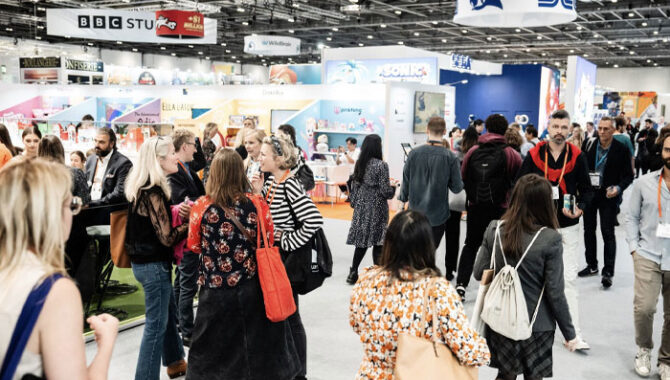—-
To stay in the loop with the latest features, news and interviews from the creative community around licensing, sign up to our weekly newsletter here

Start Licensing’s Ian Downes picks the brains of some BLE attendees to find out what jumped out at them as key design trends.
As the dust has settled on this year’s Brand Licensing Europe, we talked to a number of attendees about their ‘design takeaway’ from the show. BLE is of course a focal point and hub for all things licensing, but sometimes the fact that it acts as a bellwether for design trends in the industry can be overlooked.
From a design perspective, it provides a one stop opportunity to take in a lot of new products, design developments and, of course, catch up with industry colleagues. We asked people to share a noteworthy product, trend or conversation from the show with us. It was interesting to get a cross section of views from designers, licensees and agents. It was also revealing that there were a number of recurring themes and observations around topics like sustainability. Products of Change were mentioned more than once as an organisation that has helped the licensing industry think and act more sustainably.
From my own perspective, there were three particular trends that BLE reinforced for me. Firstly, there seems no slowing down in the licensing industry’s appetite for collaborations. There are numerous examples of brands working together to develop bespoke or limited-edition ranges. These partnerships and design initiatives seem to receive universal praise within the industry and attract a lot of positive PR.
“There seems no slowing down in the licensing industry’s appetite for collaborations.”
In the consumer market, they can help achieve cut through while they also create a platform for marketing communications. Design-wise, they can be a spur for other partners. But I think there has to be a cautionary note added that they can also potentially dilute a brand’s impact in the market – and can also raise issues around deal terms… My sense is that ‘collabs’ are here to stay, but maybe need to be used more sparingly at times.
I also noticed that the heritage sector is still in a period of growth. In my own work, our client The Ashmolean Museum took the opportunity to exhibit for the first time at BLE this year. This reinforced their commitment to licensing and also specifically allowed them to have direct design discussions with interested parties. They were actually positioned on the show floor near Park Agencies, their apparel licensee partner. This led to some very effective discussions with retailers where Park and the Ashmolean were able to showcase designs directly to retail buyers.

Seemingly retailers are keen to hear directly from heritage licensors and to discuss design directly with them. This is in part because of their desire to ensure the heritage designs they use have an authenticity associated with them, and that there’s a well-developed backstory to tell alongside the designs.
The third observation I made was that there seems be an ongoing demand for and interest in Kawaii style properties and designs. Fuelled by retailers like HMV and TruffleShuffle, it’s a trend that’s succeeding in its own right – but one that’s also influencing design direction on other brands and fuelling new IP development.
A good example of this is a brand we are working on called Pembe the Pink Cat; we announced our representation of the brand at BLE and the brand owner was also exhibiting at the show. We had a really strong response to Pembe – in part because of its market positioning but also because the team behind the brand have invested heavily in design.

It’s a property that has a substantial artwork bank ‘ready to use’. This design approach allows a brand to get to market quickly, accelerates the approvals process and allows partners to refresh product quickly. The latter point seems to be vital with fan-driven brands. I think brand owners will need to invest further in design in coming years as the retail market fragments and there are more demands from partners looking for unique designs.
“It’s great to see brands increasingly focusing on reducing waste and promoting product re-use.”
Here are the thoughts of a number of other industry experts we talked to about design, trends and BLE…
Christa Mavroudis & Paula Rich, Dot Dash Designs
We really enjoyed BLE this year – the whole vibe seemed very vibrant and optimistic! We were really looking forward to the keynote with Sara Davies – who did not disappoint. She spoke about how she got into licensing with the Flower Fairies over 20 years ago. She was super inspiring and her collab with the Mood Bears also caught our attention.

These colourful, heartwarming bears were so eye-catching; not just for their appealing colours but for the powerful message they carry. In a time where mental health is more crucial than ever, especially for children, Mood Bears offer a comforting way for kids to express their emotions and understand that it’s okay to feel a range of moods.
What makes Mood Bears so impactful is how they serve as emotional companions, helping children navigate their feelings in a way that’s both approachable and soothing. In today’s fast-paced and often overwhelming world, kids are under more pressure than ever—whether it’s from school, social media, or personal struggles. We feel this generation needs more emotional support, and products like Mood Bears play a vital role in providing that.
“Things are still tough out there, but it felt like there was a fight in the air.”
By giving children a tangible way to relate to their feelings, we can encourage emotional intelligence and resilience at a young age. Supporting products like Mood Bears is about more than just offering a toy – it’s about nurturing a generation that understands the importance of mental well-being. This is why they made such an impression on us and why they deserve the spotlight.

 Samira Henley, Jewel Branding
Samira Henley, Jewel Branding
It was refreshing to see a nod to sustainability at Brand Licensing Europe 2024, as a promising sign of where the industry is heading. One of the standout initiatives was the Products of Change booth, which emphasised eco-friendly products and practices. This platform highlights the industry’s growing commitment to addressing environmental concerns, from reducing carbon footprints to adopting sustainable materials. Brands with a strong focus on sustainability, like the Wombles, the New York Botanical Garden, London Zoo, and RHS were also showcased.
In more general terms, it’s great to see brands increasingly focusing on reducing waste and promoting product reuse, tapping into the growing consumer demand for sustainable goods. Licensing partnerships now often include requirements for recycled materials, eco-friendly packaging and ethical production practices. This push towards sustainability reflects the broader role the licensing industry can play in shaping consumer behaviour. It’s crucial that these discussions continue to gain traction, as the licensing sector has significant power to influence change – not just in products, but in how consumers engage with sustainability in their everyday lives. This momentum at BLE is a clear indication that the industry is evolving towards more responsible, impactful practices.
 Danny Heffer, Freelance Creative
Danny Heffer, Freelance Creative
A very clear take out was that buzz was back… The sparkle, the shine, the ‘rizz’ – look it up grandad, I’m down with the kidz – had come back to BLE. It’s been a tough few years for the show, with the transition to Excel, the pandemic and tough economic conditions. I felt a distinct change in the air this time. Things are still tough out there, but it felt like there was a fight in the air. The stands were bold and confident with a visible spend in 3D and visuals… And interactivity has become a real thing now. Mattel’s stand was practically a funfair of great shareable moments. The character costumes were out in force, and it felt well attended and busy with an interesting seminar programme. This all manifested in a really strong looking show with some great variety of work to see.
I’m seeing lots of ‘softer’ trends coming through; it’s not about yer’ big brassy vectors anymore. Rights & Brands and Penguin Ventures are really leading that classier, premium look and feel. This elevates those sectors that lean into this so it was good to see the heritage sector so well represented too.
Dare I say it but it felt better than the Olympia days?
 Kelly Gunstone, Winning Moves
Kelly Gunstone, Winning Moves
One of the key design takeaways from BLE this year was the increasing importance of sustainability in licensing. As the world evolves, brands are becoming more conscious of their environmental footprint, and consumer products are evolving to prioritise being eco-friendly and sustainable. It was great to have conversations around using sustainable materials, reduced plastic and recyclable packaging – making toys and games that are actively aware of the impact they have on the environment.
What was most interesting was that the shift to sustainable licensing wasn’t just about materials; it was about telling a story. Brands are using their platforms to educate consumers on environmental issues, turning product choices into opportunities for positive impact. The trend is clear: sustainability isn’t just a feature – it’s becoming a necessity for brands to stay relevant and responsible in today’s market.
It was great to see licensors like Hasbro expanding their sustainability efforts with the Monopoly: Go Green Edition, made from FSC-certified wood, and the board being made from 100% recycled paper. This not only aligns with consumer demand for greener products but also sets new standards for the licensing industry as a whole.

For us at Winning Moves, it’s key to see what steps industry giants like Mattel and Hasbro are taking to reduce their carbon footprint and make products that are more sustainable. It’s a great step in the right direction for the whole industry.
 Carrie Hickman, The Ashmolean Museum
Carrie Hickman, The Ashmolean Museum
After three years of attending BLE as a visitor, 2024 was the first time I attended as an exhibitor. Three years ago, as a newcomer to licensing, I noticed a small heritage brand on the end of a row with a minimal stand with a handful of visuals and I thought to myself: ‘That’s the main thing: they’re here, and they’re ready to talk’. I’ve watched and admired as that same brand has exhibited every year since and with an increasingly impressive offering from a wide range of licensees.
And that’s been my takeaway this year, as I represented the Ashmolean Museum in close proximity to some huge, international mega-brands: just to be there… Ready to talk, listen and be inspired in this incredibly creative, diverse and progressive industry.

Despite being the world’s oldest Museum, the Ashmolean are relative newcomers to licensing and have been part of some fantastic collaborations so far. I was thrilled to be able to represent what we’ve achieved, to shout about the incredible collections we represent and to have face to face conversations with dozens of interested passers-by – in addition to the many pre-arranged meetings. The only thing better than that is a visit to the Museum itself, where we’d be more than happy to show you around!
 Sophie Jonas -Hill, Designer & Brand Owner
Sophie Jonas -Hill, Designer & Brand Owner
What I took away from BLE My view of Brand Licensing Europe may have been a little skewed by spending most of my time in the wild and wonderful realms of the Art and Discovery zone, but I got the distinct impression that the hand-drawn line is making a comeback.
Perhaps it’s a reaction to the high gloss and finish of digital art which has been a main stay of image making over the last 20 years, and the more recent – and some might say malign – influence of AI, but I felt there was a flourishing of sketchy, wobbly, perfectly imperfect line work, reminiscent of 1970s delights such as children’s classic Rhubarb and Custard.
“I got the distinct impression that the hand-drawn line is making a comeback.”
Apart from my own glorious creations, the work of Jelly Armchair really exemplified this with the work of artist Cat and pun and business generation of her sister Liz – ‘small family business, big, silly puns’ – who’s delightful silliness is combined with cheerful and proudly hand-drawn illustrations.

Hand-drawn work is relatable and familiar, reassuring and friendly compared to the perfection of digital, and it has an authenticity and humanity which is all part of the message for the right brand. You can spend hours trying to create a digital programme which recreates it – or you can, you know, ask an artist to do it for you, and get some real authenticity for your brand!
Enter your details to receive Brands Untapped updates & news.